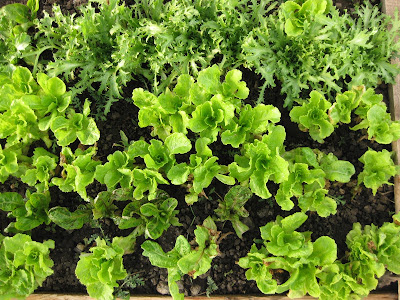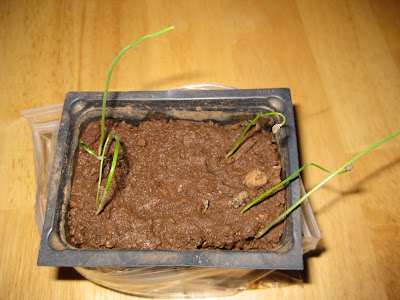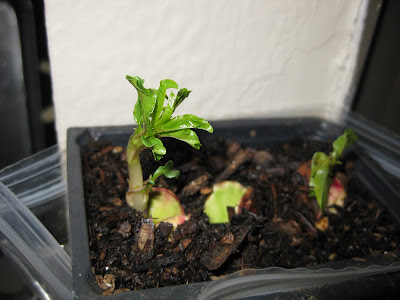This is an update from a previous post. The tree seedlings are really starting to take off and here are a few pictures.
This is a picture of some almond seedlings.
I wasn't sure if the almonds would grow because I had heard so much about chemical treatments and irradiation of almonds for the "pasteurization" process required for U.S. almonds. All I did was take a few of the leftover almonds from Christmas, cracked the shells carefully to remove the kernels, placed them on a damp paper towel, sealed in a ziplock bag, and left them in the fridge until they started to germinate. I think the two look pretty good. There might be a third in a few days, we'll see.
Spitzenburg Apple Seedlings.
I started a few of these seedlings from one of my favorite apples. I'm hoping that they are at least decent tasting. If not I'll graft onto them.
Old Fashioned Red Delicious Seedlings.
These are seedlings, rather a lot of them from some 100+ year old red delicious trees. These trees have apples that are large and somewhat red, although not nearly as red and tasteless as the store-bought red delicious apples of today.
Bartlett Pear Seedlings.
These Bartlett Pear seedlings look rather haggard and mostly destroyed by fire blight and other seedling problems. I'm purposely allowing the disease to take over so that only the strong disease resistant/immune trees will survive for my orchard. I am a bit disappointed with these seedlings and am surprised since Bartlett has been used as a rootstock in the past. It doesn't look very hardy in the least.
Seckel Pear Seedlings.
I am much more impressed with the Seckel Pear Seedlings than with the Bartlett. These almost all look strong and vigorous. I've heard they can sometimes come nearly true from seed. I'll have to wait a few years to see if it is true. They look like they would make a better rootstock than Bartlett. I think I'll be planting out a number of Seckel seedlings.
Starkrimson Pear Seedlings.
Starkrimson is my favorite pear variety. I really like the taste, the thin skin, and the red color. These are somewhat damaged by blight and disease, a few have fallen over and are in the process of dying, but they are much less affected than Bartlett. Some of them look like they are going to make it, while many will not.
Red Bartlett Pear Seedlings.
These are Red Bartlett seedlings. They look pretty good so far, I'm guessing that they will be somewhat obliterated by fire blight due to the relationship to the Bartletts that already died. Maybe they have somewhat better genetics. They aren't as crowded. Maybe I'll have to induce some disease by touching them to the infected plant to kill off the weak ones and only keep the immune trees. I've done that with the others to make sure that they all were at least exposed to disease from the Bartletts.
That is the latest update on growing fruit trees from seeds. Oh, I almost forgot to mention the blackberry seedlings came up and look good. They are a little small so I haven't taken a picture of them yet. I'm pretty excited about the possibilities of some of these trees. Time will tell if they are any good.























